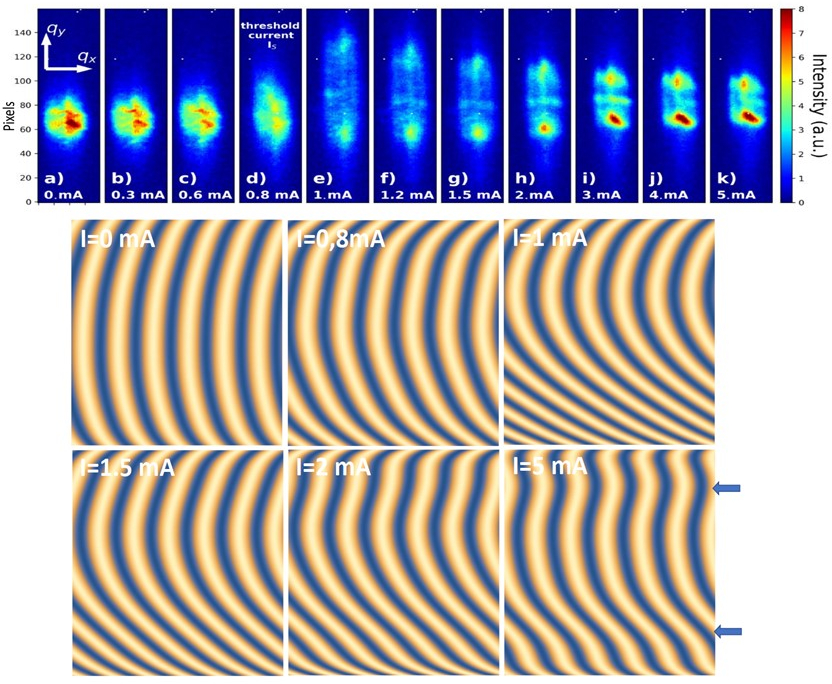
« L’automne mange sa feuille dans ma main :
nous sommes amis […].
Il est temps que le temps advienne.
Il est temps.«
P. Celan
Pavot et mémoire
Corona
David Le Bolloc’h
Research Director CNRS
Interests
- Charge Density Wave phases
- Sliding Processes and Soliton Lattices
- Coherent X-ray diffraction
- Free Electron Laser
- Pinning and Deformations
Education
- PhD « Order-Disorder in Condensed Matter » (Laboratoire Léon Brillouin CEA/LEM ONERA)
- Post doctoral position (Université de Houston UofH, Texas) /Oak Ridge /NSLS Brookhaven N.Y.
- Post doctoral position (ESRF Grenoble France)
- Research associate, Laboratoire de Physique des Solides (LPS), université Paris-Saclay
- Habilitation to supervise research (HDR), Université Paris-Saclay
Electronic crystals and coherence
Transport of charges through CDW shear
Electronic transport in CDW materials has been observed through the behavior of the underlying atomic lattice using an intense X-ray beam generated by a Free Electron Laser (XFEL). In charge density wave systems, the electrons and the atomic lattice exhibit a wave-like behavior, the two modulations being inseparable. This phase of matter is very sensitive to various external excitations, such as changes in temperature, an ultrashort laser pulse or even weak currents. In the latter case, when a direct current above a critical threshold is applied to the sample, an additional current appears in the crystal. It is naturally pulsed and is directly linked to the behavior of the CDW. This effect is explained by a CDW deformation under current, eventually breaking beyond a certain deformation limit and periodically releasing charged topological objects that travel over macroscopic distances. This phenomenon has been observed thanks to the coherent and extended X-ray beam generated from the LCLS XFEL source at Stanford. The CDW phase was deduced from the diffraction patterns by applying a genetic algorithm. The CDW exhibits astonishing spatial coherence despite its nanometer period. It continuously deforms from one edge of the crystal to the other, which is several tens of microns wide. Like a guitar string plucked at both ends that bends under the effect of a force, the wave bends under the effect of the current pinned by the two side surfaces of the crystal. This shearing effect increases as the current increases, then suddenly relaxes above the threshold current (see figure 1). The wave deforms in the transverse direction by shear but also in the longitudinal direction, like an accordion that contracts and expands (see figure 2). The two types of deformation, transverse and longitudinal, are closely coupled, with the relaxation of one above the threshold leading to the appearance of the other. In addition, the steps on the crystal surface also act as traps, preventing it from slipping (see the two arrows on Fig.1). This result illustrates the capabilities of the new XFEL sources which, combined with appropriate analysis methods, open up new perspectives for observing and understanding the behavior of electronic systems

The importance of shear on the collective charge transport in CDWs revealed by an XFEL source,
David Le Bolloc’h, Ewen Bellec, Darine Ghoneim, Antoine Gallo-Frantz https, Pawel Wzietek, Luc Ortega, Anders Madsen, Pierre Monceau, Mathieu Chollet, Isabel Gonzales-Vallejo, Vincent L. R. Jacques, and Aleksandr Sinchenko, Sci. Adv., 11, eadr6034 (2025)
Archives ouvertes : hal-04864367v1
Highlight CNRS février 2025 : https://www.inp.cnrs.fr/fr/cnrsinfo/cisaillement-dune-onde-de-densite-de-charge-observe-par-une-source-xfel
Publication list on ResearchGate:
https://www.researchgate.net/profile/David-Le-Bolloch/research
Aucun résultat ne correspond à votre demande.
Contact
- david.le-bolloch@universite-paris-saclay.fr
- +33 (0) 1 69 15 60 57
- Laboratoire de Physique des Solides, bat 510, Université Paris-Saclay, 91405 Orsay
.